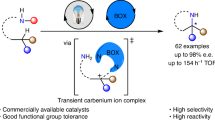Abstract
CHARGE-TRANSFER (CT) transitions in complexes with an ionic ground state, leading as they do to annihilation of the charge, are particularly sensitive to the polarity of the solvent. Such transitions have been used to derive the empirical solvent polarity parameters Z (ref. 1) and ET (ref. 2) which correlate well with the transition energies of other complexes with charged ground states3–5. Complexes in which the ground state is non-ionic show, on the other hand, little correlation between the energy of the charge-transfer transition and ET (or Z), because of the Franck–Condon restriction on reorganization of the solvent during the transition. The CT fluorescence transitions in such complexes should, however, correlate well with Z and ET provided that the lifetime of the excited state is sufficient to allow reorganization of the solvent. The energy of the CT fluorescence transition should thus decrease with an increase in solvent polarity, the reverse of the trend observed for the absorption process. Few complexes have been found to fluoresce in fluid solution6,7, and these only in a few solvents, mainly of very low polarity. The fluorescence band maxima measured in a range of solvents using a Baird-Atomic SF100 spectrofluorimeter for the complex hexamethylbenzene–tetrachlorophthalic anhydride are shown in Table 1, and Fig. 1 is a plot of the fluorescence band energy, ECT, against the solvent polarity parameter, ET. A good straight line with a slope close to unity (0.91) is obtained, showing that solvent stabilization of the excited state is very similar to that of the ground state in ionic complexes.
This is a preview of subscription content, access via your institution
Access options
Subscribe to this journal
Receive 51 print issues and online access
$199.00 per year
only $3.90 per issue
Buy this article
- Purchase on SpringerLink
- Instant access to full article PDF
Prices may be subject to local taxes which are calculated during checkout
Similar content being viewed by others
References
Kosower, E. M., J. Amer. Chem. Soc., 80, 3253 (1958).
Dimroth, K., Reichardt, C., Siepmann, T., and Bohlmann, F., Annalen, 1, 661 (1963).
Kosower, E. M., J. Org. Chem., 29, 956 (1964).
Kosower, E. M., and Ramsey, B. G., J. Amer. Chem. Soc., 81, 856 (1959).
Beaumont, T. G., and Davis, K. M. C., J. Chem. Soc., B, 1010 (1968).
Czekalla, J., and Meyer, K. O., Z. Phys. Chem., N. F. 27, 185 (1961).
Parker, C. A., and Short, G. D., Spectrochim. Acta, 23 A, 2487 (1967).
Orgel, L. E., and Mulliken, R. S., J. Amer. Chem. Soc., 79, 4839 (1957).
Beens, H., Knibbe, H., and Weller, A., J. Chem. Phys., 47, 1183 (1967).
Mataga, N., Okada, T., and Yamamoto, N., Bull. Chem. Soc. Japan, 39, 2562 (1966).
Miwa, T., and Koizumi, M., Bull. Chem. Soc. Japan, 39, 2588 (1966).
Kaneta, K., and Koizumi, M., Bull. Chem. Soc. Japan, 40, 2254 (1967).
Author information
Authors and Affiliations
Rights and permissions
About this article
Cite this article
DAVIS, K. Solvent Effects on Charge-transfer Fluorescence Bands. Nature 223, 728 (1969). https://doi.org/10.1038/223728a0
Received:
Issue date:
DOI: https://doi.org/10.1038/223728a0



